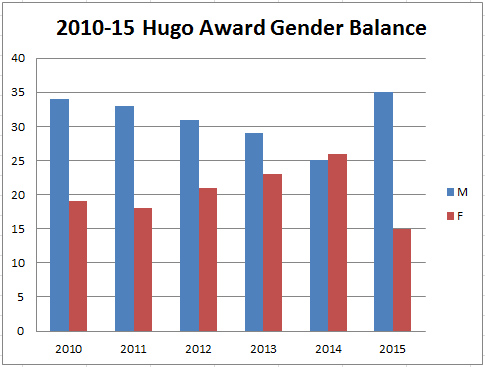Gender Balance in Hugo Nominees
Disclaimer 1: I am not a statistician. I studied some stats as a psych major, but that was two decades ago. I’m pretty good with math, but don’t ask me to calculate standard deviations or give you exact models of statistical significance here.
Disclaimer 2: This is a simplified look at the gender breakdown of Hugo Award nominees from 2010 – 2015. I used binary M/F gender for simplicity.
I started by looking at the nominees in the four fiction categories: Best Novel, Best Novella, Best Novelette, and Best Short Story. Data comes from the Hugo Awards website.

I’ve seen a lot of back-and-forth about whether or not the Sad and Rabid Puppy campaigns were racist, sexist, homophobic, etc. I highly doubt Brad Torgersen (leader of the current Sad Puppy campaign) was deliberately, consciously, and intentionally trying to favor men over women. That said, the effect of the campaigns is pretty clear here, and breaks a pattern of better gender balance going back at least five years.
Next, I checked the other categories where a single individual was nominated. (Again, I was going for simplicity here.) Those categories include the Best Editor for Short and Long Forms, Best Professional Artist, Best Fan Artist, Best Fan Writer, and the Campbell Award for Best New Writer. The Campbell is not a Hugo, but as it’s part of the same voting process and ballot, I thought I’d include it.

Both the history and the effect of the 2015 puppy campaigns are less clear cut here. While I’m not a statistician, the balance of male and female nominees in 2015 seems to fall within the range of normal variation. It breaks the four-year trend of increasing female representation, but it’s not the drastic imbalance we see in the fiction categories.
What can we conclude from this? Not too much. Diversity and representation are intersectional, and can be examined in many different ways. This is just one.
What we can say is that, when you put everything together, the puppies have brought us the most male-dominated ballot in the past six years, sharply reversing a trend toward gender equality.
Now, the first defense to this kind of thing tends to be, “I don’t care about gender (or race, or orientation, or whatever); I just want to read good stories.” To which I’d ask, “Okay…then why is it you seem to believe it’s mostly men writing those ‘good’ stories? Or is it just that your reading is biased toward male authors, so that’s all you know?”
How to wrap this up? I’m gonna do so by recommending some awesome female authors for folks to check out:
- Marie Brennan
- Nnedi Okorafor
- Elizabeth Bear
- Delilah Dawson
- Aliette de Bodard
- Karen Lord
- SL Huang
- Charlie Jane Anders
- Ambelin Kwaymullina
- Deborah Blake
- Jaime Lee Moyer
- Tanya Huff
- Eugie Foster
- Lois McMaster Bujold
- Alethea Kontis
- Seanan McGuire
- Katherine Addison
- N. K. Jemisin
I’ve reviewed many of these folks’ books over at Goodreads. If your reading has been rather imbalanced, there’s no time like the present to broaden your horizons.
Feel free to leave other suggestions in the comments!









